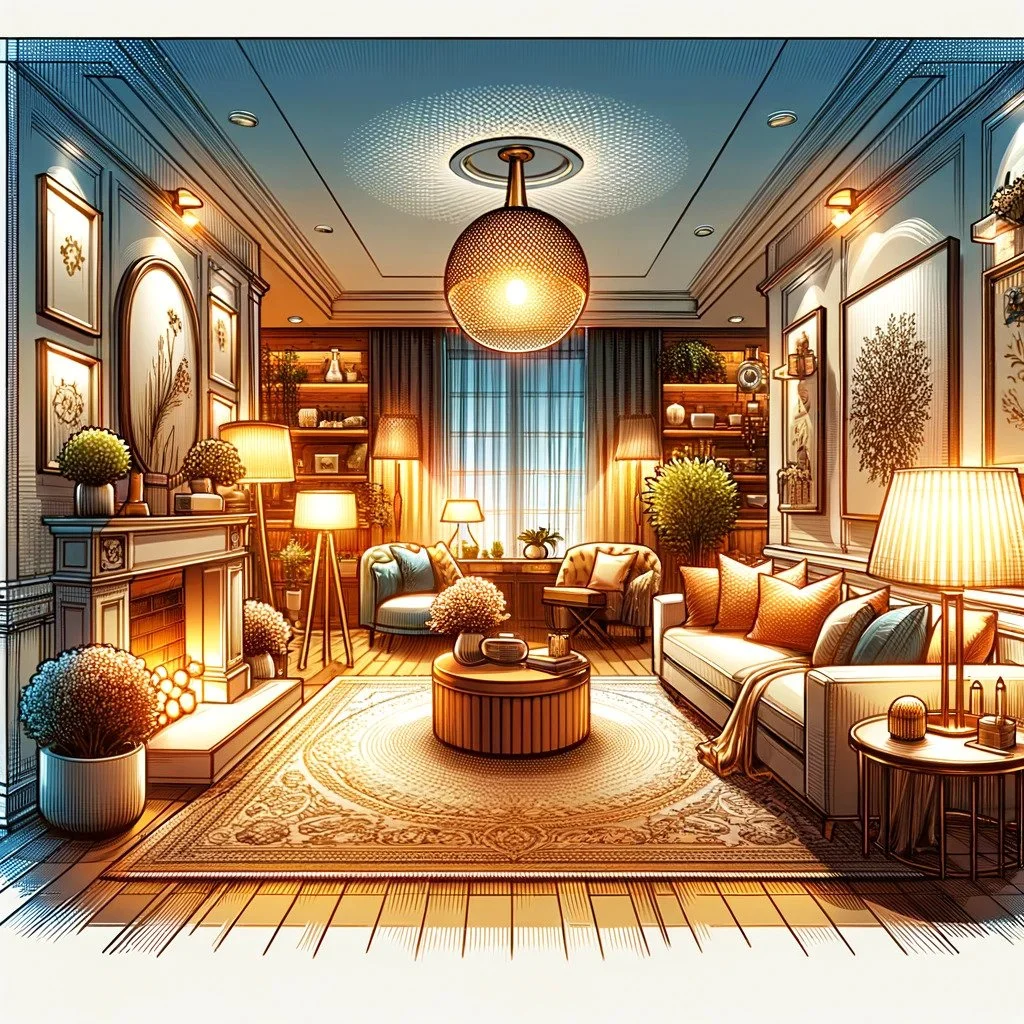Illuminating Excellence: The Ultimate Guide to Enhancing Your Home with Perfect Lighting
Dive into the transformative world of home lighting with our ultimate guide. Perfect lighting isn't just about visibility; it's about creating ambiance, enhancing aesthetics, and defining the functionality of every corner in your home. Whether embarking on a new home journey, aiming to sell, or simply wanting to refresh your living space, understanding the nuances of recessed, accent, and dramatic lighting can elevate your environment from simple to stunning. Join us as we illuminate the essentials of lighting design, ensuring your home radiates warmth, style, and sophistication.
The Importance of Lighting in Home Design
Lighting is a cornerstone of home design, influencing not just how we see our space but also how we feel within it. Beyond its practical application, lighting dictates the atmosphere of a room, accentuates architectural and design elements, and can even affect our well-being. The American Lighting Association notes that properly designed home lighting improves task performance, makes spaces appear more inviting, and enhances colors. This section delves into the psychological impacts of lighting, the balance between aesthetics and utility, and how different lighting layers work together to create harmonious spaces.
Recessed Lighting: The Subtle Art of Ambiance
Recessed lighting, with its ability to blend seamlessly into the ceiling, offers a minimalist yet effective lighting solution. It's particularly suitable for modern homes where clean lines and uncluttered spaces are prioritized. This lighting type can be strategically placed to wash walls with light, enhance room dimensions, and provide uniform illumination. We'll explore the technical aspects, such as lumens for brightness, beam angles for coverage, and the importance of IC-rated fixtures for safety. Additionally, we discuss creative applications of recessed lighting in various rooms to enhance functionality without compromising on style.
Accent Lighting: Highlighting Beauty and Detail
Accent lighting is your tool for storytelling within a space, allowing you to spotlight prized possessions, artwork, or architectural features. It's about adding layers and depth, creating points of interest that guide the eye through a room. The art of choosing the right fixtures to complement your decor, affects the science of placement to optimize impact, and balancing intensity to avoid overpowering your space. From under-cabinet lighting in kitchens to picture lights in galleries, we'll show you how to use accent lighting to celebrate your home's unique elements.
Dramatic Lighting: Making a Statement
Dramatic lighting serves as the jewel in the crown of your lighting scheme. It's about making bold choices that reflect your personality and set the tone for your living spaces. Whether it's an intricate chandelier that commands attention in the dining room or sculptural sconces that add intrigue to hallways, this section examines how statement lighting can transform ordinary rooms into extraordinary showcases. We'll also touch on the latest trends in dramatic lighting, including sustainable materials and LED innovations, offering inspiration for those looking to make a sustainable yet stylish impact.
Integrating Smart Lighting for Convenience and Efficiency
The evolution of smart home technology has brought lighting control into the palm of our hands. With features like dimming, color temperature adjustments, and programmable scenes, smart lighting systems not only offer ultimate convenience but also help in reducing energy consumption. Citing the Smart Home Technology Report, we'll dive into how integrating smart lighting can lead to a more adaptive and responsive home environment, enhancing both the functionality and security of your space. Tips on selecting compatible systems, integrating with voice assistants, and maximizing the benefits of smart lighting will be covered.
Commonly Asked Questions,
1. How do I balance natural and artificial lighting in my home design?
- Balancing natural and artificial lighting involves leveraging the strengths of each to achieve a harmonious lighting scheme. Start by maximizing natural light exposure through strategic window placement and treatment choices. Complement this with artificial lighting by layering different types, such as ambient, task, and accent lights, to ensure even illumination throughout the day. The goal is to use artificial lighting to subtly enhance natural light during the day and replicate its warmth and direction in the evening.
2. What are the best lighting solutions for high ceilings?
- High ceilings offer a dramatic canvas for lighting, but they also pose unique challenges. Pendant lights and chandeliers can add visual interest and bring light closer to the living space. Recessed lighting can provide ambient illumination without cluttering the ceiling. For task lighting, consider floor lamps or wall-mounted lights. Track lighting is versatile and can be adjusted to highlight architectural features or artwork.
3. How can lighting improve small or dark spaces effectively?
- In small or dark spaces, the right lighting can make a significant difference. Use multiple light sources to create depth and eliminate shadows. Wall sconces and under-cabinet lighting can brighten walls and work areas without taking up valuable space. Mirrors strategically placed opposite light sources can also amplify light, making the space feel larger and brighter. Opt for light colors in decor to reflect light further and enhance the sense of space.
4. How do I choose the right color temperature for my lighting?
- Color temperature is crucial in setting the mood of a room. Warm white (2700K – 3000K) is ideal for living rooms and bedrooms, creating a cozy and inviting atmosphere. Cool white (3500K – 4100K) suits kitchens and bathrooms, offering a more energized feel. Daylight (5000K – 6500K) is perfect for task lighting or areas requiring high visibility. The Lighting Research Center provides guidelines for selecting optimal color temperatures based on room function and desired ambiance.
5. What lighting is recommended for a home office to enhance productivity?
- For home offices, a combination of ambient lighting and task lighting is recommended to reduce eye strain and enhance productivity. Ambient lighting should fill the room without causing glare, while task lighting, such as desk lamps, should be adjustable and focused on work areas. Studies by the Illuminating Engineering Society suggest that incorporating daylight through windows, complemented by LED task lighting, can significantly improve concentration and comfort.
6. Can outdoor lighting improve home security?
- Yes, outdoor lighting is a key component of home security. Strategic placement of motion-sensor lights around entry points, pathways, and dark corners of your yard can deter potential intruders. The International Dark-Sky Association emphasizes the importance of choosing outdoor lighting that provides adequate illumination without contributing to light pollution, ensuring safety while respecting the environment.
7. How does lighting design contribute to energy efficiency in a home?
- Lighting design plays a significant role in a home's energy efficiency. Opting for LED bulbs, which use at least 75% less energy than incandescent lighting, can drastically reduce energy consumption. Incorporating natural light, using dimmers, and implementing smart lighting systems that adjust based on occupancy and time of day can further enhance energy savings. The U.S. Department of Energy offers resources on energy-efficient lighting design and practices.
Mastering the art of home lighting opens up endless possibilities to enhance the beauty, comfort, and efficiency of your living spaces. From the subtlety of recessed lighting to the boldness of dramatic fixtures, each choice plays a pivotal role in crafting the desired ambiance. As we've explored, smart integration and thoughtful design can transform your home into a sanctuary that not only looks good but also feels right.
Call to Action:
Illuminate your home's potential with expert lighting solutions. Whether seeking to dazzle buyers or simply to revel in the beauty of well-lit spaces, our team is here to guide you. Contact us today, and let's brighten your home together, one light at a time.
Providing Sources:
- American Lighting Association
- Lighting Research Center
- Illuminating Engineering Society
- International Dark-Sky Association
- U.S. Department of Energy
- National Association of Realtors (NAR)
- Zillow Real Estate Market Reports
- MaineHousing
- MassHousing
- Tax Foundation
- American Lighting Association
- Smart Home Technology Report



